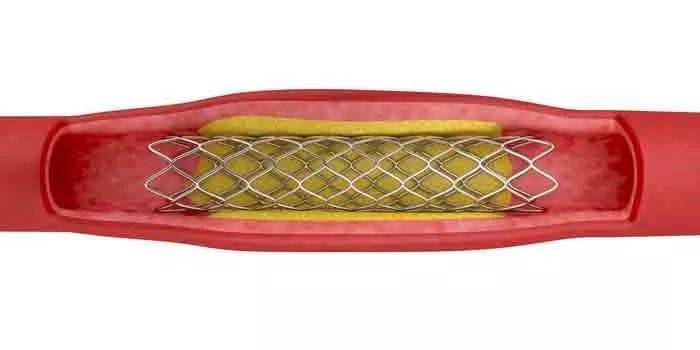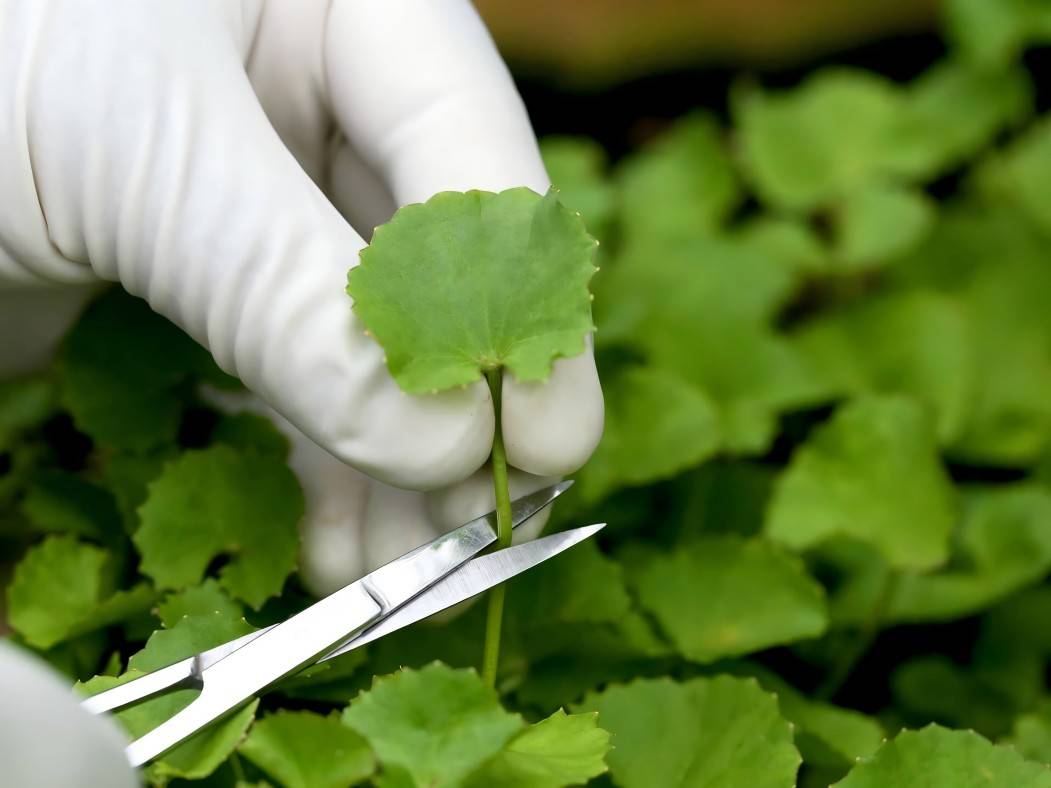What Is the Benefit of Gotu Kola Herb Extract?
Asiaticoside (AS) is an active ingredient of Gotu Kola Herb. Modern pharmacological studies have confirmed that asiaticoside has a variety of effects, including neuroprotection, anti-tumor, anti-ischemic reperfusion injury, anti-stent restenosis, and lung protection. This article reviews the pharmacological effects of asiaticoside and its potential mechanisms of action.
1 Neuroprotective effects
1.1 Anti-Parkinson's disease (PD)
In the classic MPTP-induced PD animal model, MPTP is oxidized to MPP+ in the substantia nigra, which inhibits mitochondrial complex enzymes and further causes abnormal function of the sodium-potassium pump. This pump abnormality can be alleviated by AS [1]. Bcl-2, as an anti-apoptotic factor, can bind to the apoptotic protein Bax to reduce the effect of Bax. The ratio of Bcl-2/Bax dominates the “fate” of the cell. MPTP can effectively reduce Bcl-2 while increasing the expression of Bax, promoting the occurrence of apoptosis. In the MPTP-AS combination group, AS significantly alleviated the decrease in Bcl-2 and the increase in Bax [1]. Electron microscopy showed more obvious histological changes in the MPTP group than in the MPTP-AS combination group. These changes included more irregular vesicles and more fibrous deposits in the MPTP group [1].
1.2 Anti-Alzheimer's disease (AD)
Rats treated with asiaticoside and huperzine A performed better than the control group in the water maze experiment and the passive avoidance experiment, and this change was dose-dependent [2]. The content of superoxide dismutase (SOD), glutathione (GSH) and glutathione peroxidase (GSH-PX) in the brain tissue of AD-affected rats was lower than that of normal rats, while the content of malondialdehyde (MDA) and nitric oxide (NO) was significantly higher than that of normal rats. After taking AS, this situation improved significantly. Furthermore, Asiaticoside can increase the content of nerve growth factor in AD rats, and more importantly, AS can reduce the expression of β-amyloid (Aβ) [2].
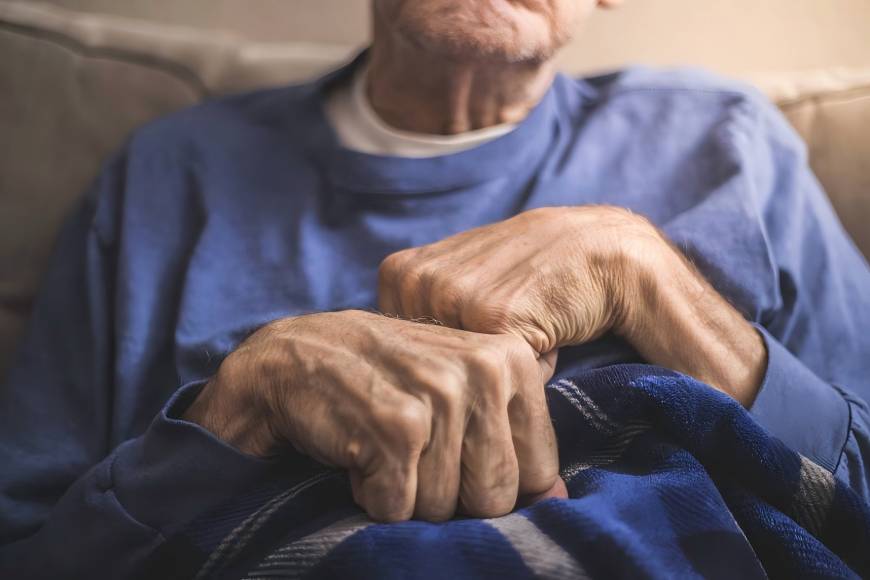
1.3 Antidepressant effect
Depression is associated with abnormal molecular and cellular functions under the combined influence of genes and environment [3]. The brain can mature, differentiate and function through the intake of neurotrophic factors (BDNF). Whether BDNF can bind/activate tyrosine protein kinase receptor B (TrkB) constitutes the basis of the pathophysiology of depression [4]. In addition, stress factors can reduce BDNF levels in the prefrontal cortex and hippocampus, and this reduction can be corrected by antidepressant treatment [5].
In the sucrose preference test, the amount of sugar water drunk by rats in the depression group was significantly lower than that of the normal group; while the amount of sugar water drunk by rats treated with Asiaticoside and fluoxetine was significantly higher. Similar behavioral changes and therapeutic effects were also observed in the forced swimming test [6]. In the prefrontal cortex, stress causes a decrease in BDNF, and Asiaticoside does not alleviate this change, while fluoxetine can. Stress does not cause changes in synapsin I, but it can cause a decrease in SPD-95, and neither AS nor fluoxetine can do anything about it [6]. In the hippocampus, stress significantly reduced BDNF, synapsin I, and SPD-95. Fortunately, these changes could be alleviated by asiaticoside and fluoxetine [6]. AS-induced changes in rat behavior could be completely blocked by an inhibitor of the TrkB pathway (K252a). In the prefrontal cortex, K252a did not change the effect of Asiaticoside on BDNF and synapsin I. In the hippocampus, the increase in BDNF, synapsin I and SPD-95 caused by Asiaticoside was completely blocked by K252a [6]. In summary, AS exhibits significant antidepressant effects, which are related to its promotion of hippocampal BDNF, synapsin I, and SPD-95 expression. The efficacy of AS can be inhibited by K252a, which indicates that AS needs to act through the BDNF-TrkB pathway.
2 Anti-breast cancer effect
7, 12-dimethylbenz(a)anthracene (DMBA) is a commonly used agent for inducing breast cancer [7]. MIBI is a commonly used anti-cancer radiopharmaceutical. In cell culture experiments, Asiaticoside promoted caspase-3-mediated programmed necrosis of MCF-7 cells, and this effect showed a significant dose-dependent effect [8].
In the DMBA-induced breast cancer experiment, the tumor volume in the AS+DMBA group was significantly smaller than that in the DMBA group alone. This reduction was not only reflected in the tumor volume, but also in the AS+DMBA group's reduced uptake of the specific radiotracer MIBI, and this reduction showed a dose-dependent effect.
In addition, tumorigenesis is often associated with chronic inflammatory processes, and the role of the inflammatory factors tumor necrosis factor (TNF) and interleukin (IL)-6 in promoting tumorigenesis and development has been recognized. The anti-cancer effect of asiaticoside is correlated with its anti-TNF-α and anti-IL-1β expression effects [8].
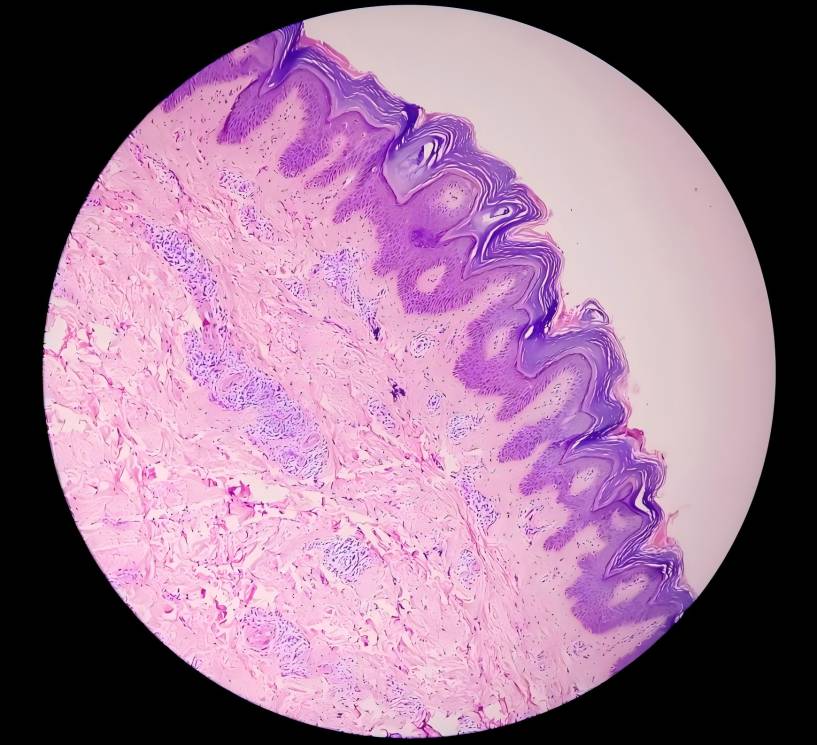
3 Anti-ischemic reperfusion injury
Cerebral ischemia-reperfusion is the main cause of dementia. Inflammation is involved in the entire process of ischemia-reperfusion injury [9]. Oxygen free radicals produced during the inflammatory process can cause damage to the blood-brain barrier, abnormal mitochondrial function, and destruction of the cytoskeleton. Microglia are the first line of defence in the central nervous system and play an important immune role[10]. Microglia can produce a variety of cytokines including IL-1β, IL-6 and TNF-α, and the expression of these cytokines is positively correlated with the degree of ischemia[11].
In a rat model of cerebral ischemia-reperfusion injury, the behavioral performance of rats in the AS group in the water maze was significantly better than that of the experimental group, and the content of NO and iNO in the brain tissue of rats in the Asiaticoside group was reduced. Asiaticoside can significantly reduce the content of IL-1β, IL-6, and TNF-α[12], showing a good anti-ischemic-reperfusion injury effect.
4 Prevention and treatment of stent restenosis
Percutaneous coronary artery access currently faces two major problems: restenosis and late thrombosis after coronary stent placement. Extracellular matrix (ECM) accounts for about 80% of the components of restenosis, and transforming growth factor-β (TGF-β) is a key factor regulating ECM secretion [13]. Rapamycin is a macrolide drug with strong anti-inflammatory and anti-cell proliferation effects. The use of rapamycin to produce coated stents can prevent restenosis after coronary artery stenting [14].
In vitro culture of human aortic fibroblasts and smooth muscle cells revealed that the AS+rapamycin group had significantly reduced TGF-β1 expression and significantly enhanced Smad7 expression, significantly inhibiting the expression of type I collagen [15].
5 Protective effect on the lungs
5.1 Anti-pulmonary arterial hypertension (PAH)
Pulmonary vascular remodeling is a central link in the pathogenesis of PAH [16]. Therefore, slowing and reversing pulmonary vascular remodeling is a central link in the treatment of PAH. TGF-β Ⅰ can mediate the release of NOX4 and oxygen free radicals through Smad2 and 3, and cause medial remodeling [17].
In an Asiaticoside comparison experiment, AS significantly reduced the mean pulmonary artery pressure (mPAP) of rats in a hypoxic environment, reduced the infiltration of inflammatory cells in the pulmonary artery, and completely prevented the thickening of the media [18].
Experimental analysis of the data suggests that asiaticoside significantly reduces the expression of TGF-βR Ⅱ but has no significant effect on TGF-βR Ⅰ. Asiaticoside can reduce the content of TGF-β Ⅰ in a dose-dependent manner and can inhibit the phosphorylation of Smad2/3, but has no significant effect on the total amount of Smad2/3 [18].
At the same time, the effect of AS in preventing PAH is also related to its ability to induce apoptosis of medial smooth muscle cells [18].
5.2 Anti-acute lung injury (ALI)
Lipopolysaccharide (LPS) plays a key role in the pathogenesis of ALI due to its ability to cause the activation of various inflammatory cells [19]. The nuclear transcription factor NF-κB plays a key mediating role in lung diseases [20]. In addition, IκB is an inhibitor of NF-κB.
In cell experiments, AS can reduce LPS-mediated phosphorylation of IκB and dose-dependently reduce TNF-α and IL-6 levels [21].
In animal experiments, AS was able to alleviate the lesions caused by LPS, such as edema, hemorrhage, and thickening of the alveolar wall. The neutrophil content in the AS+LPS group was lower than that in the pure LPS group. The changes in IκB, TNF-α, and IL-6 were consistent with the cell experiments [21].
6. Blood glucose control
Type 2 diabetes is marked by abnormal blood glucose conversion, and evidence shows that long-term consumption of non-nutritive calories can lead to a decrease in the clearance rate of blood lipids, which in turn reduces the conversion rate of blood glucose. This indicates that abnormal blood lipid metabolism can, to a certain extent, manifest as symptoms of type 2 diabetes [22]. The accumulation of lipids in the body can lead to an increase in macrophages, which in turn leads to an increase in TNF-α. Chronic inflammatory processes can cause the degradation of fat cells and the release of more free fatty acids, which worsens insulin resistance [23].
Compared with 203 herbal medicines, Asiaticoside can effectively promote fat synthesis. It also inhibits the secretion of IL-6 induced by TNF-α, which reduces blood lipid concentration. It plays an effective inhibitory role in the occurrence and progression of diabetes[24].
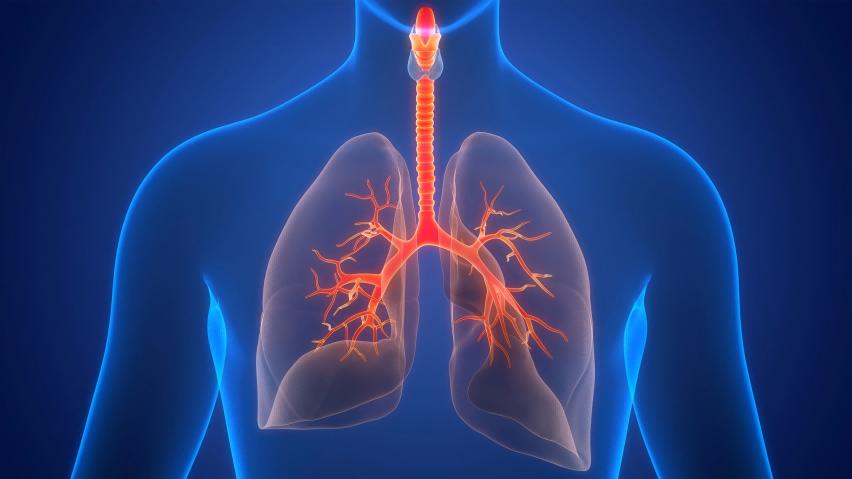
7 Anti-ulcer effect
Inducible nitric oxide synthase (iNOS) is found in both acute and chronic inflammation. iNOS can cause the aggregation of various inflammatory factors and an increase in NO in macrophages and neutrophils, which exacerbates the inflammatory process. In an experiment using acetic acid to induce gastric ulcers, Asiaticoside, like the iNOS inhibitor (1400W), accelerated the healing of gastric ulcers and inhibited iNOS activity. Moreover, its efficacy was dose-dependent [25].
8 Anti-atherosclerotic effect
Endothelial cell damage is the initial stage of atherosclerosis. Studies have found that TNF-α and TNF-α receptors are significantly overexpressed in atherosclerotic lesions. An increase in TNF-α levels can cause pathophysiological processes including increased vascular permeability and monocyte aggregation. Among these, the regulation of TNF-α on the endothelium is not dependent on myosin contraction regulation, but is achieved through the reorganization of intercellular adhesion proteins in endothelial cells. Actin includes two forms: globular actin (G-actin) and fibrillar actin (F-actin), which in turn form the cell skeleton structure. The balance between the two affects the integrity of endothelial cells [26].
In vitro experiments have found that TNF-α can cause a relative increase in F-actin, which in turn causes changes in the permeability of the arterial intima. AS cannot inhibit the relative increase in F-actin, but it can change the arrangement of actin proteins, thereby protecting the endothelial barrier [27].
9 Anti-hypertrophic scar effect
TGF-β is a key factor in regulating the wound healing process and collagen accumulation, while the Smad protein family is its specific signal transducer[28] . Regulation of Smad proteins can effectively inhibit the formation of hypertrophic scars. Among them, the Smad7 protein has a clear inhibitory effect on the collagen-accumulating effect of TGF-β.
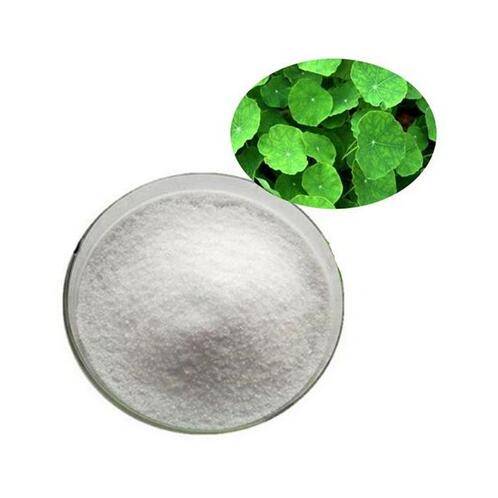
In vitro culture of human fibroblasts found that Smad7 protein was significantly overexpressed in Asiaticoside medium, and the peak expression was at an Asiaticoside concentration of 250 mg/L. This indicates that AS can effectively inhibit the formation of hypertrophic scars [29].
In addition, Asiaticoside has a variety of pharmacological effects such as cognitive enhancement and anti-epilepsy. Research on these effects and their mechanisms of action will provide new hope for the treatment of more patients.
Reference:
[1] Sampath U , Janardhanam VA. Asiaticoside , a trisaccaride triterpene induces biochemical and molecular variations in brain of mice with parkinsonism[J] . Translational Neurode- generation , 2013 , 2(1) :23.
[2] Lin X , Huang R , Zhang S , et al. Beneficial effects of asiati- coside on cognitive deficits in senescence-accelerated mice[J] . Fitoterapia , 2013 , 87(1) : 69.
[3] Krishnan V , Nestler EJ . The molecular neurobiology of de- pression[J] . Nature , 2008 , 455 :894-902.
[4] Lee BH , Kim YK. The roles of BDNF in the pathophysiolo- gy of major depression and in antidepressant treatment[J] . Psychiatry Investig, 2010 , 7 :231-235.
[5] Yi LT , Li J , Liu BB , et al. BDNF-ERK-CREB signalling mediates the role of miR-132in the regulation of the effects of oleanolic acid inmale mice[J] . J Psychiatry Neurosci , 2014 , 39 : 348-359.
[6] Luo L , Liu XL , Mu RH , et al. Hippocampal BDNF signa- ling restored with chronic asiaticoside treatment in depres- sion-like mice[J] . Brain Research Bulletin , 2015 , 114 : 62- 69.
[7] Salami S , Karami TF. Biochemical studies of apoptosis in- duced b y tamoxifenin estrogen receptor positive and negative breast cancer cell lines[J] . Clin Biochem. 2003 , 36 :247-253.
[8] Al-Saeedi FJ . Study of the cytotoxicity of asiaticoside on rats and tumour cells[J] . BMC Cancer , 2014 , 14(1) :220.
[9] Costantino I , Josef A. The immunology of stroke : from mechanisms to translation[J] . Nat Med , 2011 , 17(7) : 796- 808.
[10] Tambuyzer BR , Ponsaerts P , Nouwen EJ . Microglia : gate- keepers of central nervous system immunology[J] . J Leuko Biol , 2009 , 85(3) :352-370.
[11] Doyle KP , Simon RP , Stenzel-Poore MP. Mechanisms of is- chemic brain damage[J] . Neuropharmacology , 2008 , 55(3) : 310-318.
[12] Chen S , Yin ZJ , Jiang C , et al. Asiaticoside attenuates mem- ory impairment induced b y transient cerebral ischemia-reper- fusion in mice through anti-inflammatory mechanism [J] . Pharmacol Biochem Behav , 2014 , 122 :7.
[13] Leask A , Abraham D J . TGF-beta signaling and the fibrotic response[J] . FASEB J , 2004 , 18(7) : 816.
[14] Schwarts SM. Smoothmus clemigrationina therosclerosis and restenosis[J] . J Clin Invest , 1997 , 100:587-589.
[15] Hou Shiqiang, Fang Ming, Chen Shasha, et al. The biochemical regulatory mechanism of asiaticoside in preventing restenosis [J]. Chinese Journal of Traditional Chinese Medicine, 2014, 39(8): 1479-1484.
[16] Michelakis ED , Wilkins MR , Rabinovitch M. Emerging con- cepts and translational priorities in pulmonary arterial hyper- tension[J] . Circulation , 2008 , 118 : 1486-1495.
[17] Sturrock A , Cahill B , Norman K , et al. Transforming growth factor-beta1induces Nox4 NAD(P) H oxidase and reactive oxygen species-dependent proliferation in human pulmonary artery smooth muscle cells[J] . Am J Physiol Lung Cell Mol Physiol , 2006 , 290:L661-L673 .
[18] Wang XB , Wang W , Zhu XC , et al. The potential of asiati-coside for TGF-β1/Smad signaling inhibition in prevention and progression of hypoxia-induced pulmonary hypertension [J] . Life Sci , 2015 , 137(4) :56.
[19] Rubenfeld GD , Caldwell E , Peabody E , et al. Incidence and outcomes of acute lung injury[J] . N Engl J Med , 2005 , 353 : 1685-1693.
[20] Yang R , Yang L , Shen X , et al. Suppression of NF-κB path- way b y crocetin contributes to attenuation of lipopolysaccha- ride-induced acut elung injury in mice[J] . Eur J Pharmacol , 2012 , 674(2-3) :391-396.
[21] Qiu J , Yu L , Zhang X , et al. Asiaticoside attenuates lipopo- lysaccharide-induced acute lung injury via down-regulation of NF-κB signaling pathway[J] . Int Immunopharmacol , 2015 , 26(1) : 181-187.
[22] Slawik M , Vidal-Puig AJ . Lipotoxicity , overnutrition and energy metabolism in aging[J] . Ageing Res Rev , 2006 , 5 : 144-164.
[23] Guilherme A , Virbasius JV , Puri V , et al. Adipocyte dys- functions linking obesity toinsulin resistance and type 2dia- betes[J] . Nat Rev Mol Cell Biol , 2008 , 9 :367-377.
[24] Babish JG , Pacioretty LM , Bland JS , et al. Antidiabetic screening of commercial botanical products in 3T3-L1adipo- cytes and db/db mice[J] . J Med Food , 2010 , 13(3) : 535- 547.
[25] Guo JS , Cheng CL , Koo MW. Inhibitory effects of centella asiatica water extract and asiaticoside on inducible nitric oxide synthase during gastric ulcer healing in rats[J] . Planta Medi- ca , 2004 , 70(12) : 1150-1154.
[26] Waschke J , Curry FE , Adamson RH et al. Regulation of ac- tindynamics is critical for endothelial barrier functions[J] . Am J Physiol Heart Circ Physiol , 2005 , 288 : H1296-H1305 .
[27] Fong LY , Ng CT , Zakaria ZA , et al. Asiaticoside inhibits tnf-α-induced endothelial hyperpermeability of human aortic endothelial cells[J] . Phytother Res , 2015 , 29 ( 10) : 1501- 1508.
[28] Schiffer M , von Gersdorff G , Bitzer M , et al. Smad protein- sand transforming growth factor-beta signaling[J] . Kidney Int Suppl , 2000 , 58 : 45-52.
[29] Qi SH , Xie JL , Pan S , et al. Effects of asiaticoside on the expression of Smad protein b y normal skin fibroblasts and hy- pertrophic scar fibroblasts[J] . Clin Exp Dermatol , 2008 , 33 (2) : 171-175.


 English
English French
French Spanish
Spanish Russian
Russian Korean
Korean Japanese
Japanese